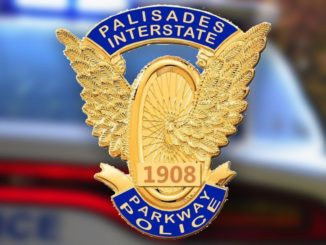
BY MICHAEL OLOHAN
OF NORTHERN VALLEY PRESS
The Bergen County Prosecutor’s Office issued a critical report July 12 on the Palisades Interstate Parkway police detailing numerous violations—including unauthorized high-speed pursuits exceeding 100 mph and use of the internet to lure small-scale narcotics dealers to PIP-patrolled property to arrest them—and outlined remedial measures taken, including a 90-day suspension of its police chief effective July 16.
‘Failure to supervise’
Although Police Chief Michael Coppola was suspended 90 days due to numerous violations uncovered and “failure to properly supervise the department” by the PIP Commission, the Prosecutor’s Office “strongly advised [the PIP Commission] to direct the chief to attend police management training upon his return from suspension,” states their report.
According to media reports, the commission’s executive director, Jim Hall, said the chief’s suspension was “appropriate” based on the investigation’s findings but declined to speculate on the chief’s status following suspension.
The Prosecutor’s Office— under Acting Prosecutor Dennis Calo—also recommended that a law enforcement professional with management experience “update the policies and procedures of the department and ensure the [PIP police] adheres to these policies…as well as Attorney General and BCPO directives.”
A motorcyclist’s death
The report followed eight months of monitoring and review by Bergen County Prosecutor’s Office, initiated following the death of a motorcyclist in May 2017 during a high-speed pursuit, which combined with other incidents indicated “a potential pattern of violations,” said BCPO’s report.
The BCPO’s five-page investigative report found parkway police regularly violated state pursuit guidelines that bar officers from initiating high-speed pursuits unless the suspect had committed specific criminal offenses, or posed an imminent danger to police or public.
Pursuits violated guidelines
The BCPO report found that PIP police broke state pursuit policy guidelines in 36 of 41 high-speed chases since January 2014.
Moreover, in 23 reported pursuits, officers exceeded 100 miles per hour and in 13 cases, police vehicles reached speeds exceeding 120 miles per hour.
In addition, a review of police records from January 2014 through August 2017 revealed police: wrongly used roadblocks three times; illegally hit fleeing suspects’ cars twice; used police vehicles to box in suspects’ cars twice; pursued suspects into oncoming traffic four times; illegally pursued suspects driving down parallel roads 10 times; and used two police vehicles to pursue a suspect seven times without getting a supervisor’s approval.
The report also found that the police department frequently ignored state rules on properly investigating officers who were accused of misconduct.
“The Pursuit Policy provides that during a pursuit, when approaching an intersection or any location where there is an increased likelihood of collision, an officer must reduce speed and cautiously proceed through the intersection,” notes the report.
“The PIPPD (police department) violated this guideline on eight occasions, most of which had multiple violations during the same pursuit. In one of these pursuits, the officer exceeded 100 miles per hour in a 25 mph zone, speeding through multiple red lights before the fleeing violator lost control and struck two parked cars,” states the report.
No departmental investigations
In addition, it found “there were no [internal affairs] investigations of any of these violations and no discipline of officers for any of the violations.”
The investigation found that the PIP police used the internet to lure small-scale drug dealers to police-patrolled property and arrest them, often resulting in intrusions into other departments’ jurisdictions. In one case cited by investigators, a man died when he fell from a cliff while trying to evade officers after a motor vehicle stop. The incident was not reported to the Prosecutor’s Office as required, the report states.
Following review of the incident and similar drug-sting operations, the department was ordered to stop by the Prosecutor’s Office. Similar to the police pursuit violations, the Prosecutor’s Office investigation determined the department conducted no internal investigations or disciplining of officers involved in these drug operations.
Misused tactics and awards
In addition to numerous incidents pursuing vehicles without cause and recklessly, the BCPO report revealed a Palisades Interstate Parkway Police Department that misused police tactics and awards, offering $200 meal allowance incentives, better parking spaces and newer police vehicles to officers who wrote the most tickets or made the most arrests.
The report also found the police chief with “a potential severe conflict of interest” due to the chief’s relationship with CJIS Solutions, an information technology company, that provides IT services to the department. It recommended severing the chief’s relationship with CJIS, although it stated criminal action was not warranted.
The report found that the Palisades Interstate Parkway Police Association—while representing itself as a charitable organization—was “clearly a labor organization” focused on officers’ functions and officers’ rates of pay.
No criminal action was needed, said the Prosecutor’s Office, but it recommended the state Division of Consumer Affairs review the association’s operations and advised the PIP Commission to conduct its own review for possible administrative action.
Officers retrained
Following installation of a monitor by the Prosecutor’s Office, the department’s 28 officers were also retrained on Attorney General policies regarding pursuits, use of force, bias crimes and racially influenced policing and internal affairs procedures, the report said.
‘To our knowledge, during direct oversight by the monitor [begun November 2017] there have been no violations by the [department] of any Attorney General or BCPO directives and the [department] has performed its core patrol function well.”
“This indicates that, with proper direction, the [department] can be a disciplined and effective law enforcement agency,” the report notes.
‘A breakdown…in command’
State Assemblyman Gordon Johnson—a longtime critic of the PIP police—said the report found “a breakdown in the chain of command” between a chief and his officers and between Palisades Interstate Park Commission and the chief.
Johnson charged the commission “does not have the ability to manage this [police department].”
Johnson noted seven years ago, the department was accused of various wrongdoings, such as racial profiling and harassing same-sex couples.
“It was obvious then that there was a problem,” he said.
Johnson said he would propose a bill in September to help fix deep-seated problems.
The bill would transfer authority over the PIP police to the state Attorney General or State Police; require the Attorney General to appoint a civilian police director to oversee the PIP police; move the PIP police budget from the state Department of Environmental Protection and put it under the state Attorney General’s Office; and require officers to write moving violations under Title 39 instead of Title 32.
“There’s no reason why a chief cannot have full command over a department of only 28 officers,” Johnson noted.
BCPO continues monitoring
The report concludes noting the Prosecutor’s Office “stands ready to assist whomever the (PIP Commission) may appoint to ensure the proper functioning of the department.” It then adds it will continue to monitor the police department “until it is capable of efficient operation without direct oversight.”
The Palisades Interstate Parkway Police Department patrols an 11-mile stretch of the parkway in New Jersey that runs from George Washington Bridge in Fort Lee to the Bear Mountain Bridge in New York.
The department’s officers patrol the Palisades Interstate Park, an elongated sliver of forested parklands, trails and cliffs that span about 12 miles between the New York State line and Fort Lee.


